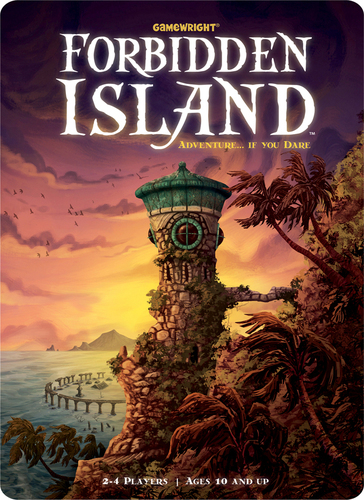
The Basics:
- Ages 7 and up
- For 2 to 4 players
- 20 minutes to complete
Geek Skills:
- Active Listening & Communication
- Logical & Critical Decision Making
- Reading & Writing
- Risk vs. Rewards
- Cooperative & Team Play
Learning Curve:
- Child – Moderate
- Adult – Easy
Theme & Narrative:
- Find treasure and escape from the island before it sinks!
Endorsements:
- Father Geek approved!
- Child Geek approved!
Overview
Forbidden Island, designed by Matt Leacock and published by Gamewright in 2010, is a cooperative game whose theme and complexity are ideal for school-age children and adults. The overall feel of this game is similar to one of Leacock’s earlier and extremely successful designs, Pandemic.
Each player controls an adventurer, represented by a colored pawn. The island is made of 24 unique locations represented by vividly illustrated cardboard tiles, each of which has a flooded side (in monochrome blue) and an unflooded side (in full color). Flooded locations are serviceable in every respect, but are just one card flip away from sinking into the abyss (i.e., removal from the game).
There are 2 decks of cards, a flood deck and a treasure deck. The flood deck consists of 24 cards corresponding to the 24 island locations, while the treasure deck is comprised mostly of cards depicting one of the 4 desired treasures.
On his turn, a player may take up to 3 actions, an action being:
- to move his pawn one space orthogonally;
- to shore up a flooded tile that his pawn is on or adjacent to, by turning it back to its unflooded side;
- to give a treasure card to another player whose pawn is on the same tile as his; or
- to cash in 4 matching treasure cards to collect the corresponding treasure, so long as his pawn is on the appropriate tile (each treasure has two possible collection points).
After taking actions, he collects 2 treasure cards, then draws flood cards. The island tiles corresponding to the cards drawn are flipped to their flooded side if not already flooded, and removed from the game if already flooded. The pace of flooding accelerates as the game progresses. As island locations disappear, movement options become restricted, opportunities to collect treasure may be lost, and the flood deck is cycled through more quickly. If the adventurers take too long to complete their task, they will find themselves overwhelmed by the flooding.
There are 6 possible adventurers, each with a unique special power. The pilot can fly himself (teleport) once per turn as a move action; the diver can swim through flooded or missing tiles, the explorer can use diagonally adjacent tiles as well as orthogonally adjacent ones for movement and shoring up; the navigator can move other players’ pawns two spaces as an action; the engineer can shore up 2 tiles in a single action; and the messenger can gift treasure cards to any other players regardless of location. Each of these powers, if applied appropriately, improves the efficiency with which the adventurers can achieve their goals.
Final Word
Forbidden Island is a great game for adults to play with school children. It is yet another exception to the sweeping generalization I made about Gamewright games in my review of Horse Show. The game is easy to explain to newcomers and remains fun for us even after one dozen plays in the last 3 weeks. The components are attractive and durable and the price is affordable to say the least.
Experienced players can set themselves a greater challenge by starting the game at a higher rate of flooding. In our family, we have graduated from Novice level to Normal and we have lost only one game so far. I expect that were we to play at Elite level (the highest is Legendary), we would be losing more often, and relying to a greater extent on good fortune to win. I do emphasize to my children that winning is not as important as having fun and trying one’s best, but in this case, greater difficulty does not guarantee greater enjoyment.
Games like this (i.e., cooperative games in which all players are privy to the same information) are at risk of “degenerating” into an exercise in which one dominant personality determines the optimal strategy and barks orders at the other players. It is crucial to make sure that all players have a chance to contribute to the discussion. With this caveat, I have found that the game is an excellent opportunity for children to apply their communication skills (clear speaking and active listening) and to work as a team, recognizing and exploiting the strengths of other team members.
Discover more from Father Geek
Subscribe to get the latest posts sent to your email.






This is an outstanding game and one I find I would rather play than Pandemic, more times than not. Even with adults!
Pingback: 2011 Spiel des Jahres Nominations » Father Geek
Pingback: Terra » Father Geek
Pingback: Father Geek » Castle Keep
Pingback: » Joe Name It Game Review
Pingback: » Meteor Game Review
Pingback: » Oz Fluxx Game Review
Pingback: Flash Point: Fire Rescue Game Review » Father Geek